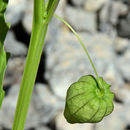fi
nimet breadcrumb-navigoinnissa


Nile region.
Native to North America, naturalized in warm regions.
Physalis angulata is an erect herbaceous annual plant belonging to the nightshade family Solanaceae. Its leaves are dark green and roughly oval, often with tooth shapes around the edge. The flowers are five-sided and pale yellow; the yellow-orange fruits are borne inside a balloon-like calyx. It is native to the Americas, but is now widely distributed and naturalized in tropical and subtropical regions worldwide.
The plant produces edible fruit that can be eaten raw, cooked, jammed, etc. However, all other parts of the plant are poisonous.[2] Members of the Toba-Pilagá ethnic group of Gran Chaco traditionally eat the ripe fruits raw.[3]
Physalis angulata is an erect herbaceous annual plant belonging to the nightshade family Solanaceae. Its leaves are dark green and roughly oval, often with tooth shapes around the edge. The flowers are five-sided and pale yellow; the yellow-orange fruits are borne inside a balloon-like calyx. It is native to the Americas, but is now widely distributed and naturalized in tropical and subtropical regions worldwide.
The plant produces edible fruit that can be eaten raw, cooked, jammed, etc. However, all other parts of the plant are poisonous. Members of the Toba-Pilagá ethnic group of Gran Chaco traditionally eat the ripe fruits raw.